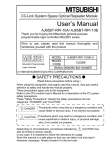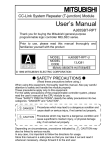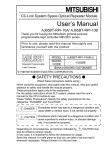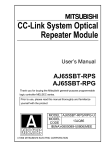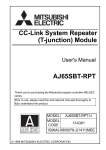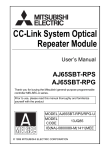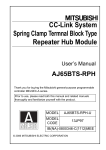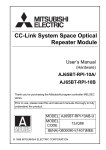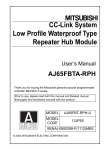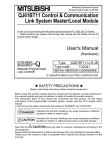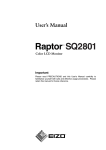Download CC-Link System Repeater (T-junction) Module User's Manual
Transcript
CC-Link System Repeater (T-junction) Module User’s Manual AJ65SBT-RPT Thank you for buying the Mitsubishi general-purpose programmable logic controller MELSEC series. Prior to use, please read this manual thoroughly and familiarize yourself with the product Mitsubishi Programmable Logic Controller MODEL AJ65SBT-RPT-U MODEL 13JQ81 CODE IB(NA)-0800078-C(0002)MEE © 1999 MITSUBISHI ELECTRIC CORPORATION SAFETY PRECAUTIONS (Read these precautions before using.) When using this equipment, thoroughly read this manual. Also pay careful attention to safety and handle the module properly. These precautions apply only to this equipment. Refer to the CPU module User's Manual for a description of the PC system safety precautions. These "Safety Precautions" classify the safety precautions into two categories: "DANGER" and "CAUTION". DANGER Procedures which may lead to a dangerous condition and cause death or serious injury, if not carried out properly. CAUTION Procedures which may lead to a dangerous condition and cause superficial to medium injury, or physical damage only, if not carried out properly. Depending on circumstances, procedures indicated by CAUTION may also be linked to serious results. In any case, it is important to follow the directions for usage. Store this manual in a safe place so that you can take it out and read it whenever necessary. Always forward it to the end user. [DESIGN PRECATUIONS] DANGER Input/output could be switched on or off when a problem occurs in the repeater module. So build an external monitoring circuit that will monitor any input/output signals that could cause a serious accident. CAUTION Use each module in an environment as specified in the "general specification" in the CPU module User's Manual. Usage of the module outside the general specification range may cause electric shock, fire, malfunction, product damage or deterioration. Do not have control cables and communication cables bundled with or placed near by the main circuit and/or power cables. It may cause malfunction due to noise interference. Wire those cables at least 100mm(3.94 inch) away from the main circuit and/or power cables. [INSTALLATION PRECAUTIONS] CAUTION Do not directly touch the module's conductive parts. Doing so could cause malfunction or trouble in the module. Tighten the module securely using DIN rail or installation screws within the specified torque range. Loose terminal screws may cause falling, short circuit or erroneous operation. If the terminal screws are too tight, it may cause falling or short circuit due to damage of the screws. [WIRING PRECAUTIONS] DANGER Perform installation and wiring after disconnecting the power supply at all phases externally. If the power is not disconnected at all phases an electric shock or product damage may result. CAUTION Be sure to ground the FG terminal to the class-D (class 3) or higher sequencer dedicated grounding conductor. Otherwise there will be an electric shock or misoperation. Terminal screws which are not to be used must be tightened always. Otherwise there will be a danger of short circuit against the bare solderless terminals. Perform correct wiring for the module according to the product's rated voltage and terminal arrangement. Connecting to a power supply different from the rating or mis-wiring may cause fire and/or trouble. A-1 [WIRING PRECAUTIONS] CAUTION Fix terminal screws securely with the specified torque. Loose terminal screws may cause short circuit or malfunction. If the terminal screws are too tight, it may cause falling, short circuit or erroneous operation due to damage of the screws or module. Make sure foreign objects do not get inside the module, such as dirt and wire chips. It may cause fire, trouble or malfunction. Be sure to fix the communication and power cables that are connected to the module in place, either by running them through a duct or by using clamps. If the cables are not fixed in one of these ways, dispersion, movement, or careless pulling of the cables may cause damage to the module or cables, or malfunction due to cable contact faults. When disconnecting a communication or power supply cable from the module, do not pull on the cable itself. Before disconnecting the cable from the terminal block, loosen off the screws of the terminal block. If you pull the cable connected to the module, the module or cable can be damaged or misoperation can occur due to cable connection fault. [STARTUP AND MAINTENANCE PRECAUTIONS] DANGER Do not touch terminals when the power is on. It may cause an electric shock or malfunction. Perform cleaning the module or re-tightening of terminal screws after making sure to turn off the external power supply. If you do not switch off the external power supply, it will cause trouble or malfunction of the module. CAUTION Never try to disassemble or modify module. It may cause trouble, malfunction, injury or fire. The module case is made of resin; do not drop it or subject it to strong shock. Module damage may result. Make sure to switch all phases of the external power supply off before installing or removing the module to/from the panel. If you do not switch off the external power supply, it will cause trouble or malfunction of the module. [DISPOSAL PRECAUTIONS] CAUTION When disposing of this product, treat it as industrial waste. A-2 REVISIONS The manual number is given on the bottom left of the back cover. Print Date Manual Number Revision Oct.,1999 IB (NA)-0800078-A First edition (Japanese only) Nov.,1999 Feb.,2000 IB (NA)-0800078-B English is added. IB (NA)-0800078-C Correction Section 3.2, Capter 5 This manual confers no industrial property rights or any rights of any other kind, nor dose it confer any patent licenses. Mitsubishi Electric Corporation cannot be held responsible for any problems involving industrial property rights which may occur as a result of using the contents noted in this manual. © 1999 MITSUBISHI ELECTRIC CORPORATION A-3 CONTENTS 1. OVERVIEW ...................................................................................................1 1.1 Features ..................................................................................................1 1.2 Packaged parts........................................................................................2 1.3 Abbreviated names, generic names and terms........................................2 2. SYSTEM CONFIGURATION.........................................................................3 2.1 Total configuration ...................................................................................3 2.2 Cautions on system configuration............................................................4 3. SPECIFICATIONS.........................................................................................5 3.1 General specifications .............................................................................5 3.2 Performance specifications......................................................................5 3.3 Specifications of connection cables .........................................................5 3.4 Max. transmission distance .....................................................................6 4. PROCEDURE UP TO START OF DATA LINK ..............................................7 4.1 Procedure up to start of data link .............................................................7 4.2 Mounting and installation .........................................................................7 4.2.1 Cautions on handling.......................................................................7 4.2.2 Installation environment.................................................................10 4.3 Names and settings of parts ..................................................................11 4.4 Check of module state (Hardware test)..................................................13 4.5 Setting of switches.................................................................................14 4.6 Installation and removal of protective cover ...........................................15 4.7 Connection of module through CC-Link dedicated cable .......................16 4.8 Check for state of connection (Line test)................................................17 5. TROUBLESHOOTING ................................................................................18 6. EXTERNAL DIMENSIONS DIAGRAM.........................................................18 About the Manuals The following manuals are related to this product. Referring to this list, please request the necessary manuals. Related manuals Manual Name AJ61BT11, A1SJ61BT11 CC-Link System Master Local Module User's Manual (Detail version) AJ61QBT11, A1SJ61QBT11 CC-Link System Master Local Module User's Manual (Detail version) QJ61BT11 CC-Link System Master Local Module User's Manual (Detail version) CC-Link System Small Type Remote I/O Module User's Manual (Detail version) A-4 Manual Number (Model Code) IB(NA)66721 (13J872) IB(NA)66722 (13J873) SH(NA)080016 (13JL91) SH(NA)4007 (13JL72) 1. OVERVIEW This User's Manual describes the specifications, names of parts, and settings of the AJ65SBT-RPT type CC-Link system repeater (T-junction) module (hereafter abbreviated as AJ65SBT-RPT) used in the Control & Communication Link (hereafter abbreviated as CC-Link) system. 1.1 Features The AJ65SBT-RPT module is used to increase the flexibility of laying down the cables of the CC-Link system. Use of this module enables the transmission distance of the CC-Link system to be extended and the wiring to be laid down in the form of T-junction. (1) Extended transmission distance in CC-Link system Use of this module enables the transmission distance of the CC-Link system to be extended. In addition, use of multiple modules enables the transmission distance of the CC-Link system to be extended up to 10 stages. Remote station *1 Extended to 13.2 km max!! Master station IN Remote I/O station Repeater (AJ65SBT-RPT) IN IN IN IN IN OUT OUT *2 OUT OUT OUT *2 1st stage OUT *2 2nd stage *2 3rd stage 4th to 10th stages *1 Max. transmission distance at a transmission speed of 156 kbps. *2 Though it is not shown here, the other remote stations can be connected between the repeaters. (2) Enabled T-junction wiring in CC-Link system Arrangement of this module between the modules of the CC-Link system enables the CC-Link system to be wired in the form of T-junction. This is applicable to all CC-Link systems operating at transmission speeds of 10 Mbps, 5 Mbps, 2.5 Mbps, 625 kbps and 156 kbps. Master station Repeater Remote (AJ65SBT-RPT) I/O station IN Intelligent device station Remote device station OUT Remote I/O station Enabled T-junction wiring !! (3) Mountable to control panel with either screws or DIN rail This module can be mounted onto the control panel with either screws or DIN rail. 1 (4) Compact module size The module size has been reduced to the same one as that of AJ65SBTB18 type small remote I/O module. AJ65SBT-RPT Item Size mm (inch) Height Width 50.0 (1.97) 87.3 (3.44) Depth 40.0 (1.58) 1.2 Packaged parts After unpacking, make sure that those parts listed below are packaged. Part name AJ65SBT-RPT module Terminating resistances 110 1/2W (Brown, Brown, Brown) Terminating resistances 130 1/2W (Brown, Orange, Brown) Quantity 1 2 2 1.3 Abbreviated names, generic names and terms Abbreviated names, generic names and terms Description Abbreviated names, generic names and terms AJ65SBT-RPT Segment Master station Local station Remote I/O station Remote device station Remote station Intelligent device station Repeater Ready master station Master local module Master module Local module Remote module Intelligent device module Description Abbreviation of AJ65SBT-RPT type CC-Link system repeater (Tjunction) module. System between terminating resistances connected to each other through cross-over cables.The conventional CC-Link system can be said to be configured with one segment (See Section 2.1.). Station to control the data link system. One station is required for each system. Station which has a sequencer CPU and can communicate with the master station and the other local stations. Remote station processing only information in unit of bit. (AJ65BTB1-16D, AJ65SBTB1-16D, AJ65SBTB1-8 , etc.) Remote station processing only information in unit of bit and in unit of word.(AJ65BT-64AD, AJ65BT-64DAV, AJ65BT-64DAI, etc.) Generic name of remote I/O station and remote device station. Controlled by the master station. Station allowing transient transmission such as AJ65BT-R2.(Including local stations) Module for expanding the CC-Link system by connecting the segments to each other. Backup station which inherits data link control when the master station comes off parallel due to error. Generic name of QJ61BT11, AJ61BT11, A1SJ61BT11, AJ61QBT11 and A1SJ61QBT11. Generic name of QJ61BT11, AJ61BT11, A1SJ61BT11, AJ61QBT11 and A1SJ61QBT11 when these are used as the master station. Generic name of QJ61BT11, AJ61BT11, A1SJ61BT11, AJ61QBT11 and A1SJ61QBT11 when these are used as the local station. Generic name of AJ65BTB1-16D, AJ65SBTB1-16D, AJ65BT-64AD, AJ65BT-64DAV, AJ65BT-64DAI and A852GOT. Module allowing transient transmission such as AJ65BT-R2. 2 2. SYSTEM CONFIGURATION 2.1 Total configuration The total configuration employed when the AJ65SBT-RPT module is used is as shown below. [Segment (1st stage)] [Segment] Master station *1 Repeater Remote device station (AJ65SBT-RPT) Remote I/O station IN [Segment (1st stage)] OUT Terminating Terminating resistances resistances (indispensable) (indispensable) Terminating resistances (indispensable) Terminating resistances (indispensable) IN OUT Terminating resistances (indispensable) Repeater (AJ65SBT-RPT) Remote I/O station [Segment (2nd stage)] Intelligent device station *2 IN Intelligent device station OUT Remote device station Terminating resistances (indispensable) Repeater (AJ65SBT-RPT) Local station Remote I/O station Terminating resistances (indispensable) Terminating resistances (indispensable) *1 The transmission speed of each segment must be matched with that of the master station. *2 10 stages of segments max. are allowed to be used. (1) What is a repeater? This is the module for expanding the CC-Link system by connecting the segments to each other. (2) What is a segment? In the CC-Link system where repeaters are used, the equipment included between terminating resistances connected to each other through crossover cables is generally called the segment. 3 2.2 Cautions on system configuration (1) Conditions of usable master module When the AJ61BT11, A1SJ61BT11, AJ61QBT11 and A1SJ61QBT11 modules are used, those of the functional version B or later must be employed. Use the master module bearing the version 9707 B or later in the DATE column of the name plate as shown in the figure below. When the QJ61BT11 module is used, any module can be used irrespective of the version. MITSUBISHI CPU UNIT MODEL A2USHCPU-S1 PROGRAMMABLE CONTROLLER MAX 30kSTEP DATE 9707 DATE 9707 MITSUBISHI ELECTRIC CORPORATION JAPAN BD992D013H01 Year and month of manufacture B B MITSUBISHI ELECTRIC BD992D008H38 Year and month of manufacture Function version Function version (2) Max. number of modules connected to configure CC-Link system Remote I/O stations, remote device stations, local stations, ready master stations, intelligent device stations and repeaters of 64 modules max. can be connected in one segment. In the CC-Link system where repeaters are used, also the number of remote stations capable of being controlled by one master station is the same as in the other systems. For details, refer to the User's Manual of the applicable master module. (3) Max. number of stages connected to configure segment Use of this module enables communication between the master station located in a segment and a remote station located in a segment apart by 10 stages max. from the segment where the master station exists. Master station Transmission speed: At a transmission speed of 156 kbps Segment Max. 1200m (3934.43ft.) IN OUT Segment (1st stage) Max. 1200m (3934.43ft.) IN OUT Segment (2nd stage) Max. 1200m (3934.43ft.) Repeater IN OUT Segment (3rd to 9th stages) Total 8400m (43278.69ft.) IN Remote station OUT Segment (10th stage) Max. 1200m (3934.43ft.) 4 Max. transmission distance 13.2km (43278.69ft.) 3. SPECIFICATIONS 3.1 General specifications For the general specifications of the AJ65SBT-RPT module, refer to the User's Manual of the small remote I/O module. 3.2 Performance specifications The performance specifications of the AJ65SBT-RPT module are shown below. Item Transmission speed (bps) Specifications Selectable from among 156k, 625k, 2.5M, 5M and 10M Max. number of stages connected to configure segment (stage) 10 Max. transmission distance of each segment Varies according to transmission speed (See Section 3.4.). Max. number of modules connected 64 (See Section 2.2 regarding the conditions for the number of modules connected). Number of stations occupied (station) 0 (none) Settable station number Repeater power supply None Voltage (V) 20.4 DC to 26.4 DC Current (mA) 60.0 (TYP. 24 V DC) Noise durability Simulator noise of 1500 Vp-p First transient/burst noise IEC801-4: 1kV, obtained by a noise simulator using noise width of 1 s and noise frequency of 25 to 60 Hz Maximum voltage 500VAC for 1 minute between all DC external terminals and ground Insulation resistance 10M or higher, measured with a 500VDC insulation resistance tester Weight (kg) 0.2 3.3 Specifications of connection cables For the CC-Link system, use the CC-Link dedicated cables. If the cables other than CC-Link dedicated ones are used, the performance of the CC-Link system will not be assured. For the specifications of the CC-Link dedicated cables and contact address about the cables, refer to the User's Manual of the applicable master module. 5 3.4 Max. transmission distance Remote I/O station Remote device station Repeater Master station Remote I/O station Remote device station Repeater Remote I/O station Remote device station Repeater Local station Local station Ready master station Ready master station Intelligent Intelligent device station device station Remote I/O station Remote device station Repeater Max. transmission distance Conditions Description Transmission speed The maximum transmission distance in each segment is the same as that in normal CC-Link system (system configured with one segment only). The maximum transmission distance in each segment varies according to the transmission speed. For details, refer to the User's Manual of the applicable master module. (The length of the cables between repeater stations is treated in the same manner as in the remote I/O station.) Max. number of stages connected to configure segment When one connection stage is added, the maximum transmission distance is added by an amount equivalent to one segment. 6 4. PROCEDURE UP TO START OF DATA LINK 4.1 Procedure up to start of data link The procedure ranging from the installation of the AJ65SBT-RPT module to the start of data link is described below. Start Install the AJ65SBT-RPT module. Refer to Section 4.2. Check for the conditions of the AJ65SBT-RPT module (hardware test). Refer to Section 4.4. Set the switches of the module. Refer to Section 4.5. Connect the modules using CC-Link dedicated cables. Refer to Section 4.7. Check for the connection conditions of the modules (line test). Refer to Section 4.8. Start the system. Refer to the User's Manual of the applicable master module. Completion POINT The procedure described here is for the AJ65SBT-RPT module only. In order for you to understand the procedure of the entire CC-Link system, refer to the User's Manual of the applicable master module. 4.2 Mounting and installation 4.2.1 Cautions on handling Cautions on handling the AJ65SBT-RPT module are described below. DANGER Do not directly touch the module's conductive parts. Doing so could cause malfunction or trouble in the module. Perform installation and wiring after disconnecting the power supply at all phases externally. If the power is not disconnected at all phases an electric shock or product damage may result. Do not touch terminals when the power is on. It may cause an electric shock or malfunction. Perform cleaning the module or re-tightening of terminal screws after making sure to turn off the external power supply. If you do not switch off the external power supply, it will cause trouble or malfunction of the module. 7 CAUTION Use each module in an environment as specified in the "general specification" in the CPU module User's Manual. Usage of the module outside the general specification range may cause electric shock, fire, malfunction, product damage or deterioration. Do not have control cables and communication cables bundled with or placed near by the main circuit and/or power cables. It may cause malfunction due to noise interference. Wire those cables at least 100mm(3.94 inch) away from the main circuit and/or power cables. Do not directly touch the module's conductive parts. Doing so could cause malfunction or trouble in the module. Tighten the module securely using DIN rail or installation screws within the specified torque range. Loose terminal screws may cause falling, short circuit or erroneous operation. If the terminal screws are too tight, it may cause falling or short circuit due to damage of the screws. Fix terminal screws securely with the specified torque. Loose terminal screws may cause short circuit or erroneous operation. If the terminal screws are too tight, it may cause falling, short circuit or erroneous operation due to damage of the screws or module. Be sure to ground the FG terminal to the class-D (class 3) or higher sequencer dedicated grounding conductor. Otherwise there will be an electric shock or misoperation. Terminal screws which are not to be used must be tightened always. Otherwise there will be a danger of short circuit against the bare solderless terminals. Perform correct wiring for the module according to the product's rated voltage and terminal arrangement. Connecting to a power supply different from the rating or mis-wiring may cause fire and/or trouble. Make sure foreign objects do not get inside the module, such as dirt and wire chips. It may cause fire, trouble or malfunction. Be sure to fix the communication and power cables that are connected to the module in place, either by running them through a duct or by using clamps. If the cables are not fixed in one of these ways, dispersion, movement, or careless pulling of the cables may cause damage to the module or cables, or malfunction due to cable contact faults. When disconnecting a communication or power supply cable from the module, do not pull on the cable itself. Before disconnecting the cable from the terminal block, loosen off the screws of the terminal block. If you pull the cable connected to the module, the module or cable can be damaged or misoperation can occur due to cable connection fault. 8 CAUTION Never try to disassemble or modify the module. It may cause trouble, malfunction, injury or fire. The module case is made of resin; do not drop it or subject it to strong shock. A module damage may result. Make sure to switch all phases of the external power supply off before installing or removing the module to/from the panel. If you do not switch off the external power supply, it will cause trouble or malfunction of the module. When disposing of this product, treat it as industrial waste. (1) Tighten the module fixing screws and terminal block screws to those torques specified below. Do not over-tighten these screws. The screws and module case may be damaged. Screw location Specified torque range (N/cm) Module mounting screw (M4 thread with finished circular flat washer) 78 to 108 Terminal block screw (M3 thread) 59 to 88 Terminal block mounting screw (M3.5 thread) 68 to 98 (2) When a DIN rail is used, install it taking care with the following. (a) Applicable DIN rail type (conforming to JIS-C2B12) TH35-7.5Fe TH35-7.5A1 (b) Intervals of DIN rail mounting screws Mount the DIN rail by fixing it with mounting screws at intervals of 200 mm (7.87inch) or shorter. (3) To install the AJ65SBT-RPT module on the DIN rail, press, by the finger, the DIN rail hook located on the underside of the module at the centerline until you hear it click. DIN rail DIN rail hook 9 (4) When installing the AJ65SBT-RPT module on the control panel, to improve the ventilation and facilitate the replacement of the module, provide a distance of 60 mm (2.36inch) or longer between the upper and lower surfaces of the module and the structural members or parts. (5) Install the AJ65SBT-RPT module on a flat smooth surface. If there are irregularities on the installation surface, undue force may be applied to the printed circuit boards, and the boards may be damaged. (6) Depending on the grounding condition of the system, a high-frequency noise may occur between the systems. When these systems are connected through CC-Link communication cables, a communication error may occur by the mixing of noise into the repeaters. If the high-frequency noise occurs between the systems connected through the cables of 10 m (32.79ft.) or shorter, take either of the measures specified below. 2 • Connect the systems through cables of 2 mm or larger (across FG terminals of the remote station in each system, or across grounds of the control panel to which the remote station is grounded). • Use CC-Link cables of 10 m (32.79ft.) or longer between the systems. [System 1] Remote station [System 2 (Control panel which may produce noise)] AJ65SBT-RPT IN Remote station 10 m (37.79ft.) or shorter Source of high-frequency noise (servo, inverter) OUT (To the ground) Method 1: Use the stronger ground cable (2 mm 2 or larger). Method 2: Use the cables of 10 m (37.79ft.)or longer. 4.2.2 Installation environment For the installation environment, refer to the User's Manual of the applicable small type remote I/O module. 10 4.3 Names and settings of parts The names of parts of the AJ65SBT-RPT module, indication statuses of LEDs, and settings of switches are described below. 1) 4) 3) 2) PW TEST ERR. SD1 RD1 SD2 RD2 TEST RESET IN OUT B RATE 4 2 1 ON AJ65SBT-RPT DA1 IN DG1 DB1 +24V SLD 24G DG2 DA2 (FG) OUT DB2 5) NC SLD NC (FG) 6) 7) No. Name 1) Power LED Application Check for the module condition by observing the state of lighting of the LED. Application LED Name For hardware test For normal operation Goes on: Power supply is turned ON. PW Goes off: Power supply is turned OFF or reset switch is pressed. Goes on: Hardware test is under operation. TEST Goes off: Communication is under operation. Goes on: Hardware is faulty. Goes on: Communication is faulty. Switch set value is Switch set value is faulty. faulty. Flashes: Switch set value was ERR. Flashes: Switch set value was changed during changed during operation. operation. Goes off: Communication is Goes off: Normal normal. Flashes: Circuit is normal. Goes on: Data is being transmitted Goes off: Circuit is faulty. to IN side. SD1 Goes off: Data is not transmitted to IN side. Flashes: Circuit on IN side is Goes on: Data is being received normal. from IN side. RD1 Goes off: Circuit on IN side is Goes off: Data is not received from faulty. IN side. Flashes: Circuit is normal. Goes on: Data is being transmitted Goes off: Circuit is faulty. to OUT side. SD2 Goes off: Data is not transmitted to OUT side. Flashes: Circuit on OUT side is Goes on: Data is being received normal. from OUT side. RD2 Goes off: Circuit on OUT side is Goes off: Data is not received from faulty. OUT side. 11 No. Name 2) Transmissio n speed setting switch 3) Test switch 4) Reset switch 5) 6) 7) IN side terminal block OUT side terminal block Hook for DIN rail Application Set the transmission speed of the module (set to 0 at the time of delivery). Ensure to set the transmission speed at a speed specified below. Unless the speed is set at a speed specified below, the LED "ERR." will light up. Setting switch status Transmission Setting value speed (bps) 4 2 1 0 OFF OFF OFF 156k 1 OFF OFF ON 625k 2 OFF ON OFF 2.5M 3 OFF ON ON 5M 4 ON OFF OFF 10M Set the operating condition of the module (set to OFF at the time of delivery). State of switch Operating state ON Hardware test OFF Normal operation Reset the module on the hardware side (set to OFF at the time of delivery). State of switch Operating state ON Hardware reset OFF Normal operation Terminal block for connecting the CC-Link dedicated cable on the side where the power supply and master station are located. Terminal block for connecting the CC-Link dedicated cable on the side where the master station is not located. Hook for installing the module on the DIN rail. To install the module, press the DIN rail hook at the centerline until you hear it click. POINT The states of setting of the test switch and transmission speed set switch obtained when the module power supply is set from OFF to ON or the reset switch is set to OFF become effective. When the states of setting are changed with the module power supply turned ON, perform the above operations again. 12 4.4 Check of module state (Hardware test) Check that the module operates normally using the module proper. Ensure to perform this check before configuring the system. Perform the test in accordance with the steps shown below. Start Connect only the power supply cable to the terminal block. ................... Refer to Section 4.3. Set the test switch to ON (Hardware Test). ................... Refer to Section 4.3. After checking the input power supply voltage, turn on the power supply. Does "PW" light up? NO Check that the power supply is Normal normal and the power supply cable is connected correctly. NO Check that the test switch is set to ON. NO Check that the transmission speed is Normal set correctly. YES Does "TEST" light up? Normal YES Does "ERR." go off? YES Shut off the power supply. Completion The hardware may have a defect. Contact the nearest sales office, and explain the error symptom and get advice. 13 4.5 Setting of switches The setting of the switches on the AJ65SBT-RPT module is described below. (1) Test switch This switch is used to set the operating condition of the AJ65SBT-RPT module. In normal operation, set it to OFF. For detail of the setting, see Section 4.3. POINT The states of setting of the test switch obtained when the module power supply is set from OFF to ON or the reset switch is set to OFF become effective. When the states of setting are changed with the module power supply turned ON, perform the above operations again. (2) Transmission speed setting switch This switch is used to set the transmission speed of the AJ65SBT-RPT module. For detail of the setting, see Section 4.3. POINT • Set to the same state of setting as set in the master station. • The states of setting of the transmission speed setting switch obtained when the module power supply is set from OFF to ON or the reset switch is set to OFF become effective. When the states of setting are changed with the module power supply turned ON, perform the above operations again. 14 4.6 Installation and removal of protective cover A protective cover can be installed on the front surface of the AJ65SBT-RPT module to prevent foreign matter from entering the terminal blocks. The protective cover applicable to the AJ65SBT-RPT module is specified below. Procure it as necessary. Item Type Description Protective cover A6CVR-8 Cover for prevention of entry of foreign matter into terminal blocks (sold in batches of 10). To dismount and mount the protective cover on and from the AJ65SBT-RPT module, follow the steps below. (1) Mounting With the upper section of the protective cover hooked to the upper end section of the module, press the lower section of the cover until you hear it click. Click (2) Dismounting With the finger applied to the lower section of the protective cover, raise the cover upward. 15 4.7 Connection of module through CC-Link dedicated cable The method of connecting the AJ65SBT-RPT module to the CC-Link system through the CC-Link dedicated cable is shown below. Terminating resistances Master module AJ65SBT-RPT Remote module DA DA1 DA DB DB1 DB DG DG1 DG SLD FG CC-Link dedicated cable SLD FG CC-Link dedicated cable AJ65SBT-RPT Terminating resistances FG Local module DA2 DA DB1 DB2 DB DG1 DG2 DG FG Terminating resistances SLD DA1 SLD Terminating resistances CC-Link dedicated cable SLD FG CC-Link dedicated cable Terminating resistances SLD FG AJ65SBT-RPT Remote module DA2 DA1 DA DB2 DB1 DB DG2 DG1 DG SLD FG CC-Link dedicated cable SLD FG CC-Link dedicated cable Terminating resistances SLD FG Local module Terminating resistances DA2 DA DB2 DB DG2 DG SLD SLD FG CC-Link dedicated cable Terminating resistances FG Important In each segment, ensure to use the same type of CC-Link dedicated cables. If different types of cables are used, normal data transmission will not be assured. POINT • Ensure to connect the terminating resistances to both end modules of each segment. In addition, connect them between DA and DB (DA1-DB1 and DA2-DB2 for AJ65SBT-RPT). (The terminating resistances are furnished with the module.) • The terminating resistances vary according to the type of cables in use. For detail, refer to the User's Manual of the applicable master module. • Connect the shield cable of the CC-Link dedicated cable to "SLD" of each module, and ground both ends of the cable through "FG" to a class-D (class 3) ground. SLD and FG are wired to each other inside the module. 16 4.8 Check for state of connection (line test) Connect all modules including the AJ65SBT-RPT module through the CC-Link dedicated cable. Then, check that the CC-Link system is in the state capable of performing a data link normally. To perform the line test of the AJ65SBT-RPT module, use the line test 2 of the master module. For the line test 2 of the master module, refer to the User's Manual of the applicable master module. Perform the test following the steps shown below. Start Set the test switch to OFF (normal operation). After checking the input power supply voltage, turn on the power supply. Perform the line test 2 of the master module. In this test, use any one station connected to the OUT side of the AJ65SBT-RPT module. YES ................... The hardware may have a defect. Contact the nearest sales office , and explain the error symptom and get advice. Does the master module complete the line test 2 normally? NO @ g RD1h Í‚ Does "PW" light up? “_ “” µ ‚ Ä ‚ ¢ ‚ é ‚ © ‚ H NO YES Does "ERR." go off? NO YES Do "RD1" and "SD2" light up? NO YES Do "RD2" and "SD1" light up? YES Completion Refer to the User's Manual of the applicable master module. NO Check that the transmission speed is set correctly. Check that the wiring is normal. Check that there is no defective station in the Normal CC-Link system. Check that cables, power supplies and modules are arranged properly so that excessive noise is not emitted. Check that the transmission speed is set correctly. Check that the wiring on the IN side is normal. Check that the master station is normal. Check that the transmission speed is set correctly. Check that the wiring on the OUT side is normal. Check that the master station is set so that it can communicate with the remote station to be tested. Check that the remote station to be tested is normal. Perform the hardware test (See Section 4.4.) to check that the state of the AJ65SBT-RPT module is normal. Check that the other stations are normal. Check the combination of the maximum transmission distance, setting of transmission speed, and station-to-station cables. 17 Normal Normal 5. TROUBLESHOOTING Errors occurring during the data link can be checked using the ERR.LED on the master station. If the ERR.LED on the master station goes light or light-off due to an error of the data link, refer to the User's Manual of the applicable master module to check the state of the data link of the other stations of the CC-Link system. If there are many stations where an error of data link occurs on the OUT side of the AJ65SBT-RPT module, the AJ65SBT-RPT module may cause an error. Perform the line test (See Section 4.8.) again. 6. EXTERNAL DIMENSIONS DIAGRAM 40 (1.57) The external dimensions diagram of the AJ65SBT-RPT module is shown below. 78.3 +1 0 87.3 (3.44) (3.09 +0.04 ) (Mounting pitch) 0 50 (1.97) PW TEST ERR. SD1 RD1 SD2 RD2 TEST RESET IN OUT B RATE 4 2 1 ON AJ65SBT-RPT DA1 DG1 IN DB1 +24V SLD 24G (FG) DA2 OUT DG2 DB2 SLD NC 7.5 (0.30) 16.5 0.65) 2-4.5 5.1 Mounting hole (M4 mounting screw) NC (FG) 7.9 (0.31) 4 (0.16) DIN rail Unit: mm (inch) 18 Warranty Mitsubishi will not be held liable for damage caused by factors found not to be the cause of Mitsubishi; machine damage or lost profits caused by faults in the Mitsubishi products; damage, secondary damage, accident compensation caused by special factors unpredictable by Mitsubishi; damages to products other than Mitsubishi products; and to other duties. For safe use • This product has been manufactured as a general-purpose part for general industries, and has not been designed or manufactured to be incorporated in a device or system used in purposes related to human life. • Before using the product for special purposes such as nuclear power, electric power, aerospace, medicine or passenger movement vehicles, consult with Mitsubishi. • This product has been manufactured under strict quality control. However, when installing the product where major accidents or losses could occur if the product fails, install appropriate backup or failsafe functions in the system. Country/Region Sales office/Tel U.S.A Mitsubishi Electric Automation Inc. 500 Corporate Woods Parkway Vernon Hills, IL 60061 Tel : 1-847-478-2100 Brazil MELCO-TEC Rep. Com.e Assessoria Tecnica Ltda. Av. Rio Branco, 123-15 ,and S/1507, Rio de Janeiro, RJ CEP 20040-005, Brazil Tel : 55-21-221-8343 U.K Mitsubishi Electric Europe B.V. UK Branch Travellers Lane, Hatfield, Herts., AL10 8XB,UK Tel : 44-1707-276100 Germany Mitsubishi Electric Europe B.V. German Branch Gothaer Strasse 8 D-40880 Ratingen, GERMANY Tel : 49-2102-486-0 South Africa MSA Manufacturing (Pty) Ltd. P O Box 39733 Bramley 201 8 Johannesburg, South Africa Tel : 27-11-444-8080 India Messung Systems Put,Ltd. Electronic Sadan NO:111 Unit No15, M.I.D.C BHOSARI,PUNE-411026 Tel : 91-212-793130 Singapore Mitsubishi Electric Asia Pte, Ltd. 307 ALEXANDRA ROAD #05-01/02, MITSUBISHI ELECTRIC BUILDING SINGAPORE 159943 Tel : 65-470-2480 Country/Region Sales office/Tel P.T. Autoteknindo SUMBER MAKMUR Indonesia Kompleks Agung Sedayu Propertindo (Harco Mangga Dua) Blok H No.4 JI Mangga Dua Raya Jakarta Pusat 10730-Indonesia. Tel : 62-21-336292 Thailand F. A. Tech Co.,Ltd. 1138/33-34 Rama 3 Road, Yannawa, Bangkok 10120, Thailand Tel : 66-2-295-2861 Ryoden International Ltd. Hong Kong 10th Floor, Manulife Tower, 169 Electric Road, North Point, HongKong Tel : 852-2887-8870 China Ryoden International Shanghai Ltd. 3F Block5 Building Automation Instrumentation Plaza 103 Cao Bao Rd. Shanghai 200233 China Tel : 86-21-6475-3228 Taiwan Setsuyo Enterprise Co., Ltd. 6F., No.105 Wu-Kung 3rd.RD, Wu-Ku Hsiang, Taipei Hsine, Taiwan R.O.C. Tel : 886-2-2299-2499 Australia Mitsubishi Electric Australia Pty. Ltd. 348 Victoria Road, PostalBag, No 2, Rydalmere, N.S.W 2116, Australia Tel : 61-2-9684-7777 HEAD OFFICE:MITSUBISHI DENKI BLDG MARUNOUCHI TOKYO 100-8310 TELEX:J24532 CABLE MELCO TOKYO NAGOYA WORKS:1-14, YADA-MINAMI 5, HIGASHI-KU, NAGOYA, JAPAN When exported from Japan, this manual does not require application to the Ministry of International Trade and Industry for service transaction permission. Specifications subject to change without notice. Printed in Japan on recycled paper.
























